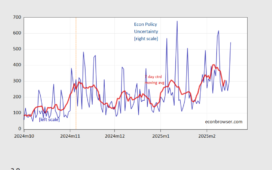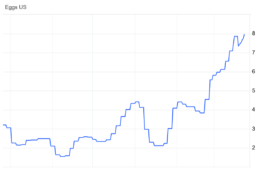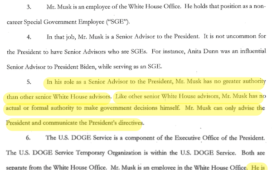For the EU, fake crises like the Russia threat and Trump abandoning NATO mean more giveaways to (mostly US) weapons companies. They mean more neoliberalism through more social spending cuts and privatizations due to lack of funds and more war on the working class.
Any threat posed by Trump (and the Biden administration or whoever comes after Trump) is the result of the very real crises of Europe’s overdependence on the US and energy prices hurting industry, but those are deemed necessary to deal with the fake crises.
Has the reemergence of the bad orange man caused any rethink about the EU strategy to “de-risk” from Russia and China and put itself at the mercy of Washington? Or are Europeans falling over themselves with pledges to increase defense spending? It’s the latter.
European Commission President Ursula von der Leyen, as usual, takes the cake. She managed to come up with a plan that would shoot the EU in both feet with her idea to buy even more gas from the US. This would increase dependence on the US while simultaneously doing even more to wreck the economies of EU states. Here’s Politico with the details:
Stressing that the EU still buys significant amounts of energy from Russia, von der Leyen asked: “Why not replace it by American LNG, which is cheaper for us and brings down our energy prices? It’s something where we can get into a discussion, also [where] our trade deficit is concerned.”
During the first Trump term, Juncker avoided more tariffs by assuring the U.S. president that Europe would facilitate more imports of liquefied natural gas (and more American soybeans.) In fact, the European Commission has no real power in determining European companies’ purchases of LNG and soybeans, but Trump was happy to accept the political theater of parading data that European purchases were going up.
There is no evidence that American LNG is cheaper, as von der Leyen is quoted as saying. It’s actually a lot more expensive than the pipeline Russian gas Europe used to get. And the European Commission does have some power in determining European companies’ purchases of LNG through its sanction powers. And the Commission doesn’t have the power to dictate purchases yet. Due to recent crises, EU member states added new instruments to Ursula’s toolbox during her first five-year term, such as the Foreign Subsidies Regulation, International Procurement Instrument, an Anti-Coercion Instrument, the Corporate Sustainability Due Diligence Directive, and the EU Critical Raw Materials Act. Maybe the latest Trump crisis will add another tool to her toolbox.
One gets the feeling that Ursula is intentionally trying to do economic damage to bloc nations in order to increase the odds she gets her coveted eurobonds. If there’s another crisis — or series of crises — she might get the chance. Countries having to throw more money at the energy crisis and shrinking GDPs could struggle to pay more for defense, which would lead to more calls for joint borrowing. Some background on the idea from Euractiv:
This miracle happened during the eurozone crisis when the EU created a legal instrument, the European Financial Stability Facility, able to issue bonds and with a lending capacity of €440 billion. And with the COVID pandemic, the miracle was repeated as the EU adopted a recovery fund with a firepower of €750 billion, financed through common debt issuance.
The same line of thinking has inspired politicians to imagine defence bonds – to finance a major boost of the EU’s defence capabilities, after years of neglect when it was assumed that war was a thing of the past or that Uncle Sam would always come to the EU’s defence…
Speaking at the European Defence Agency annual conference on 30 November, [European Council President Charles] Michel said EU member states should pool what could amount to €600 billion in defence investment over the next 10 years…
A couple of weeks later, French President Emmanuel Macron returned to the topic, telling investors at the World Economic Forum in Davos that Europe should resort to joint debt to finance its priorities, including defence.
In the ensuing months the argument for joint debt has come to include remedies for other EU problems. European heads of state met in Budapest last week with a focus on competitiveness. That’s the buzzword these days. Europe isn’t competitive enough. Mario Draghi was there pushing his sham solutions from the standard neoliberal playbook. Just consider the following. If you are worried about competitiveness do you:
- Cut off cheap and reliable energy, the lack of which makes your industry uncompetitive.
- Pursue neoliberal policies like austerity and financialization that makes your industry uncompetitive.
- Escalate a trade war with one your largest export destinations in China while being wholly unprepared for the fallout as many products the EU relies on from China like certain drugs, chemicals and materials currently have no substitutes.
Of course none of this was discussed in Budapest. National leaders instead opted for minor measures and slogans like “ensuring industrial renewal and decarbonization,” “increasing preparedness and defence capabilities,” and “putting Europe at the forefront of global research and innovation.” They’re all empty phrases without the money to back them up.
The EU is planning to redirect billions to defense from its social cohesion funds. How much remains to be seen, and there are tradeoffs.
The money used to be meant to reduce economic disparities and promote development. EU capitals will now have more “flexibility” to spend the funds to support their defense industries and military projects. According to the FT, only about five percent of the 392 billion euros allocated for 2021-2027 has been spent to date.
While Ursula and company didn’t get common EU debt yet, the crises are only picking up steam. And it should be noted that redirected social cohesion funds is considered one of the final emergency steps before turning to the joint EU debt. Ursula is unlikely to let it go as it’s the top goal of her second term.
It was only in March of this year that the idea of joint borrowing for defense was considered “radical.” Now surrounded by fake crises and self-inflicted real ones, the idea is gaining trans-Atlantic traction.
Let’s not forget that international finance is a big fan of the joint debt for defense plan. Since member states are running into budgetary constraints, investors are using the fiscal rules imposed by Brussels to push for an EU-wide bond program that would bring them big-time profits while allowing the bloc to ramp up military spending without individual nations incurring more debt. Much of Europe supports joint borrowing because in theory, there could be benefits to common debt, especially for countries like Italy which face higher borrowing costs, but going down that road to pay for the US empire ain’t it.
The two staunchest opponents to joint debt are Germany and the Netherlands. Are they prepared to withstand the pressure from financial powers, the Trump administration, and much of Europe? The signs aren’t encouraging.
The Dutch are currently killing Europe’s most valuable tech firm at the behest of the Americans for some pyrrhic and temporary victory against China.
Germany might soon be led by a former board member of BlackRock, Friedrich Merz, which will be a nebulous plus, according to Politico:
Scholz’s woes may have a silver lining for some: In Budapest, some diplomats suggested that the collapse of Germany’s ruling coalition and Merz becoming chancellor might not be a bad thing. Merz “is a former MEP so more engaged on European affairs,” said one EU diplomat who was granted anonymity to speak freely. “He’s also from the EPP, so the same family as the dominant force in [the European] Parliament, also the same family as von der Leyen, which can help at a time like this.
The Logic Behind More Defense Spending
As the FT notes, and all the media stories do the same, ‘Trump warned Nato allies earlier this year that as president he would encourage Russia to do “whatever the hell they want” if alliance members failed to meet their defence spending target.’
Yet even if Moscow wanted to invade Europe (there’s no sign it does nor any reason it would want to) what are all these extra billions going to do that all the billions and all the West’s military hardware in Ukraine couldn’t do?
So the EU argument is as follows: Trump says we must spend more, there’s nothing we can do because orange man bad and we need the US because we cut ourselves off from Russia and China.
Meanwhile real economies are imploding, and more forced austerity coming — although there has been talk about a carve out in the spending limits for defense spending.
It was always going to end this way due to a political class that sees themselves as faithful servants to the US empire and transnational capital and have nothing but scorn for the local peasants.
They’re all groveling now before Trump. It’s easy to see why:
Two percent of GDP on defense spending isn’t enough, says German Foreign Minister Annalena Baerbock.
President Duda said in his Independence Day speech that all NATO states must increase their military spending to a minimum 3%, an increase from the 2% spending target agreed on in 2014.
Trump recently also said that 3% is needed for NATO.
Poland will spend 4.7% next year 🇵🇱🇺🇸 pic.twitter.com/CuWDaGWPNf
— Visegrád 24 (@visegrad24) November 12, 2024
The thing is Europe has been spending more. In many ways Europe’s bureaucracy has already changed in small but fundamental ways in order to redirect money towards the military-industrial complex. From Equal Times:
“In 2023, there was a very significant increase in military spending worldwide, but especially in Europe. In Spain, for example, it grew by 24 per cent and in Finland by 36 per cent. If we compare it with 2013, the European countries in Nato are spending 30 per cent more,” says Pere Ortega, a researcher at the Barcelona-based Centre Delàs for Peace Studies, which is critical of measures adopted by the European Commission to promote military spending, such as the VAT exemption for the purchase of armaments or the change in the regulations of the European Investment Bank (EIB) to allow it to finance industrial projects in the military sphere.
And according to the European Council on Foreign Relations (ECFR), the number of countries meeting the two percent target has risen from 3 to 23 since 2014:

IN Germany, much has been made about the government’s scaling back of support for Ukraine, and how the cabinet’s approved military budget only increased by 1.25 billion euros to 53.25 billion this year but as WSWS points out:
…the government is actually spending far more on armaments and war. A government overview of the budget states that “taking into account the relevant shares of other individual plans,” the NATO target of military spending of at least 2 percent of gross domestic product will be achieved. With a GDP of €4.122 trillion, this means at least €82.4 billion in military spending.
The sum is probably even higher, as Scholz has already boasted of defence spending of €90 billion to NATO. In addition to the central defence budget, the government has already announced “defence-related expenditure” of €14 billion from other budget areas in the current year. Further projects totalling €20 billion will be paid from the Bundeswehr “special fund,” which totals €150 billion…In 2028, when it is expected the Bundeswehr special fund will be exhausted, the defence budget is set to rise by a huge increase of almost €30 billion to around €80 billion.
Where has it gotten them? In the case of Germany, not much, at least according to a September report from the Kiel Institute:
… the build-up of German capacities is progressing slowly. We document Germany’s military procurement in a new Kiel Military Procurement Tracker and find that Germany did not meaningfully increase procurement in the one and a half years after February 2022, and only accelerated it in late 2023.
Given Germany’s massive disarmament in the last decades and the current procurement speed, we find that for some key weapon systems, Germany will not attain 2004 levels of armament for about 100 years. When taking into account arms commitments to Ukraine, some German capacities are even falling.
The Plan All Along?
The funny thing about all the gnashing of teeth over Trump and the danger he poses to NATO, is Europe shouldering more of the American empire’s load in the Russian periphery has long been the stated goal.
If we look at what neocons, the real movers and shakers in the plutocrats and their think tanks on both sides of the Atlantic, and European politicians say, this was the plan.
Here’s a September report from the Munich Security Conference, commonly referred to as “Davos with guns”:
Russia’s aggressive revisionism has underscored NATO’s primacy in European defense. However, the real possibility of Donald Trump returning to the White House means that Europeans may soon have to seize a much larger share of the burden, both in supporting Ukraine and deterring Russia. A strong European Defence Union, based on the EU’s regulatory powers, ability to pool resources, and large single market, can become an important enabler of a more robust European pillar within NATO.
Here is a team from the influential Center for Strategic and International Studies (CSIS) writing earlier this year in Foreign Affairs about how Europe must lead in the fight against Russia so the US can focus on China:
That complicated reality requires U.S. allies, especially in Europe, to take on a larger share of directing the containment of Russia. Europe has shown its political and economic resilience in the face of Russian aggression. Yet militarily, the continent remains dependent on the United States. This dynamic must change, in part because the United States must commit more of its resources to Asia. The growth of European defense spending since Russia’s full-scale invasion of Ukraine is an encouraging step. In 2023, 11 NATO members hit their spending target, allocating at least two percent of GDP to national defense, up from just seven members in 2022. The rest need to follow suit.
Europe must also resolve the problem of coordination. Right now, the United States coordinates more than 25 militaries in Europe. While it must continue to do this in the short term, it must push individual European countries and the European Union to take over this role and to create a stronger European pillar in NATO.
The Centre for European Policy Studies with more:
Against this backdrop, the EU’s true ‘Hamiltonian moment’ in defence would be a decision to issue joint debt to properly fund the ambitions set out in its Defence Industrial Strategy.
Based on Art. 122 TFEU and implemented in accordance with Articles 173-174 TFEU, such bonds—possible under the EU’s Financial Regulation—could provide the backbone for grants to Member States to bolster the Union’s defence production capacity if paired with existing incentives for joint capabilities research, development, production, and procurement. This would avoid the two-speed logic and weaker conditionalities surrounding proposals to use the European Stability Mechanism (excluding key countries such as Poland, Sweden and Denmark) to issue loans to EU Member States for defence spending.
Like how the Covid-induced Recovery and Resilience Facility stabilised European markets and sustained demand during and after the pandemic, Euro-defence bonds are a potential game-changer for the EU’s defence ambitions due to the potential speed and scale of resource mobilisation, and the potential impact on market de-fragmentation. And, fortunately, the German Constitutional Court should have nothing to object to this time around.
And you can read the same in Scholz’s Zeitenwende, and in the speeches by Baerbock that Germany will lead the fight in Europe for the “rules-based order” while the US focuses on China.
So what’s the problem with Trump telling them to get a move on?
That they actually need to do it now rather than just talk? That Trump is more crass where someone like Biden would extol the trans-Atlantic alliance while shoving the knife in?
Whatever Trump’s motivations, the faction of ascendant neocons who favor an American exit from Ukraine while making the Europeans spend more so that Washington can focus more on Iran and China are following a path long laid out.
This is part and parcel of the neocon plan to use European vassals in an effort to preserve and expand the US empire. And the European political class is so far more than happy to go along. They don’t have much of a choice anymore:

How much longer will the bloc’s citizens cooperate? To say Europe is in free fall would be an insult to gravity. And yet despite the endless stream of awful economic news, the political class’s complete detachment from reality, the embarrassing servility to the US, there isn’t yet a major threat to Europe’s willful vassalage. Germany’s upcoming election will be interesting to see how the Alternative for Germany (AfD) and Sahra Wagenknecht Alliance (BSW) perform. The two parties come at it from different angles, but both oppose bending the knee to Washington. They are currently polling at around a combined 24.5 percent, and barring an improvement, are likely to remain out of any ruling coalition.
Until someone like the AfD or BSW can take charge, all the “crises” will continue working to the advantage of the few. Over the turbulent past few years in which real wages plummeted and deindustrialization took hold, the wealthiest added to their fortune and European Commission President Ursula von der Leyen amassed more power that she uses for interests of the Western plutocrats centered in the US.
With this being what the EU leaders of the “center” want and with the big bad orange man insisting upon more, they seem to compliment each other quite nicely.














